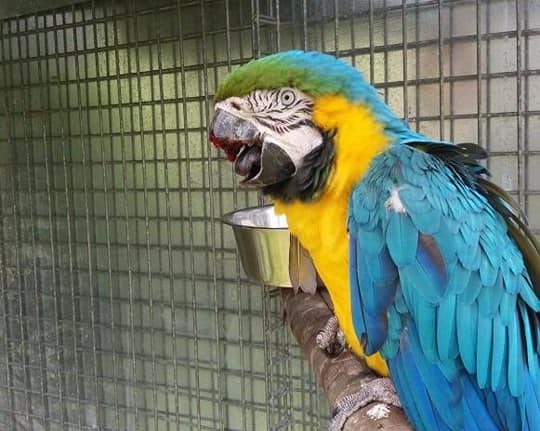Thanks to a University of Pretoria (UP) team led by Professor Gerhard Steenkamp, a veterinary specialist in dentistry and maxillofacial surgery at the Faculty of Veterinary Science, a macaw has been given a new lease on life with a 3D-printed prosthetic beak.
The Faculty of Veterinary Science, Onderstepoort‘s statement below:
Max, a blue and gold macaw from a bird sanctuary in the Western Cape, received a fully functional 3D-printed prosthetic beak after getting into two scuffles with other macaws, during which his beak was first damaged, then ripped off. The fisticuffs occurred in two separate incidents a few years ago.

Surgery was conducted recently at the Robberg Veterinary Clinic in Plettenberg Bay, with local vet Dr Brendan Tindall administering the anaesthesia, Prof Steenkamp attaching the prosthesis, and former UP professor and specialist prosthodontist Prof Cules van Heerden assisting.
“Max is doing well, and no complications have been seen with the beak so far,” said Prof Steenkamp, who was recently part of a team that performed the first CT scan on a live adult rhino at the Onderstepoort Veterinary Academic Hospital (OVAH). The macaw’s owner, Trevor Glover, who established a bird sanctuary, said that within a day of surgery, Max was eating solid pieces of food. “This is quite a change from eating only soft food for years,” he added.
The ground-breaking surgery, believed to be the first of its kind in South Africa, was performed under the leadership of Prof Steenkamp. It required collaboration with Bloemfontein’s Central University of Technology and industry partners. The work spanned nearly two years, due to the lockdown arising from the COVID-19 pandemic. The result is that Max is now eating normally with the 3D-printed titanium beak and has returned home.


“Max was brought to the sanctuary in 2017 after his owner moved overseas,” Glover said. “He was aggressive towards the rescued birds and during hormone season at the end of 2017, he attacked a macaw that retaliated by biting his top beak and cracking the left side from top to bottom.” Max was then placed in a transition aviary, along with another macaw who had an injured beak. “But in the third week together, they got into a fight, with Max’s weakened beak being ripped off completely,” Glover explained.
Max, who is estimated to be close to 20 years old, and the broken-off beak were taken to Dr Tindall for treatment and evaluation. “Brendan kept him, and over the following few days, was able to get Max to take in soft food. On Max’s return to the sanctuary, I began to feed him a hot, soft food mix of about 10 nutritious foods twice a day. His weight was monitored daily. He was hand-fed, but soon started lapping food up with his tongue. From then on, in addition to the soft food mix, he got a range of soft fruit along with almond sprinkles. As long as he could get to the food with his tongue, he could eat on his own.”
Then trouble struck a few months later as the bottom of Max’s beak continued to grow straight out, with nothing to wear it down. “The bottom of the beak grew longer than Max’s tongue; this prevented him from reaching his food,” Glover explained. “Brendan then started a routine cut-back of the bottom beak.”

Glover decided to take the bird to the OVAH for a CT scan to determine if there was enough remaining beak and bone for a prosthetic to be attached. “The CT scanner at Onderstepoort could not produce enough detail, so arrangements were made to have Max scanned by Dr Craig Muller of Eugene Marais Radiology,” Prof Steenkamp explained. “I also took impressions of the remaining beak to make sure that the prospective printed beak would fit on to the remaining stump. Both the impressions and CT scan were sent to Philip van der Walt of BunnyCorp, which proceeded to develop and draw the beak. Once we had the final drawings, the search began for someone to print the beak and make the particular screws for us.”
But then the pandemic brought things to a standstill for nearly two years. “The beak was subsequently printed by the Centre for Rapid Prototyping and Manufacturing at Central University of Technology, using additive manufacturing and a drill guide in nylon,” Prof Steenkamp said. “The Carl and Emily Fuchs Foundation funded the manufacture of the prosthetic beak, while the national Department of Science and Innovation funded the MedAdd project, providing the latest additive manufacturing technology.”
The job of creating the screws to attach the beak was contracted to Saspine, a Pretoria-based company that works in the human orthopaedic environment, which sponsored the specialised locking screws specifically developed for Max. What made the beak different was that “we developed three anchors that passed through the printed beak, all the way across the beak and locked into the prosthesis on the far end. This ‘locking mechanism’ has never been described in birds,” said Prof Steenkamp.
He explained that moulds of the stump had to be made several times to check if the beak stump had changed. The surgery lasted just over an hour. “It is amazing what can be achieved with 3D printing,” he said. “I am happy to have been part of the team that has given Max a second chance in life and would like to thank our industry partners.”
Max has returned home to a special aviary that Glover has built for him. “I am very grateful for the help, kindness, advice and dedication given by the team led by Prof Steenkamp,” Glover said. “Max has been given a new lease of life and has gone back to relatively normal behaviour – eating, flying and climbing as he did before the injury. My heartfelt thanks to all.”
Pictures: University of Pretoria, Faculty of Veterinary Science
ALSO READ
The leader of the pack: a wildlife vet saving the ‘unsaveable’


















